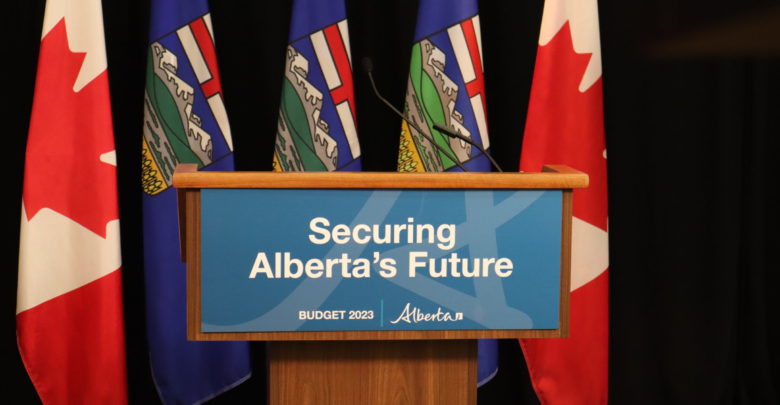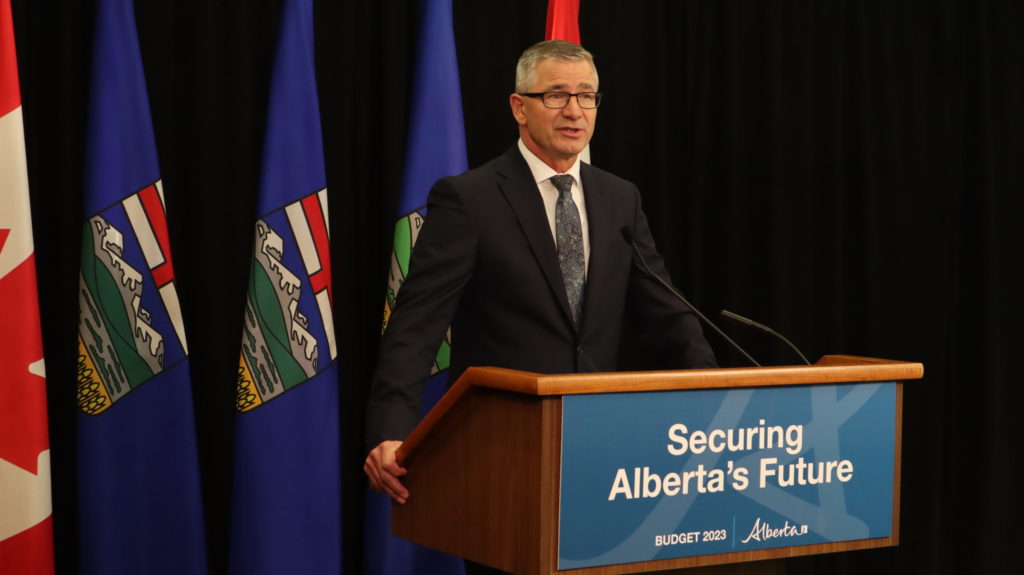BREAKING: Budget 2023’s effect on post-secondary in Alberta
Affordability measures include a two per cent tuition increase cap and changes to interest rates and grace periods for student loans.
 Emily Williams
Emily WilliamsThe Government of Alberta’s Budget 2023 features an increase of funding for post-secondary and affordability measures including a two per cent cap for tuition increases.
Released on February 28 by Minister of Finance Travis Toews, Budget 2023 outlines $66.8 million in total expenses and a budgeted surplus for the government of $2.4 billion. While the base operational funding for post-secondaries will remain largely unchanged from Budget 2022 levels, an additional $189 million will be invested over three years for targeted enrolment expansion.
$1.4 billion of the surplus will go into the Alberta Fund, which is intended to serve as a framework for unallocated surplus. The fund can be spent on holding funds, deposits into the heritage fund, and one-time spending that aligns with “strategic government priorities.”
Affordability measures will help “provide real, tangible relief” for post-secondary students
Budget 2023 includes an estimated $18 million in supports for post-secondary students, an increase of $9 million in comparison to the forecasted amount for 2022-23. There are four new affordability measures, which were first announced by Minister of Advanced Education Demetrios Nicolaides on February 16.
Interest rates on student loans will be reduced from the prime rate plus one per cent, to only the prime rate — which is the lowest commercial rate offered on loans. This is a reverse of what was brought in during Budget 2019, where the rate was increased to the prime rate plus one per cent.
At a press conference, The Gateway asked Toews what influenced the change of the interest rate back to the prime rate.
“We’ve spent three years doing the heavy-lifting, making difficult decisions, all of us as Albertans. And we got our fiscal house in order,” Toews said. “Now that gives us the ability to move spending up … this is a way that we can provide real tangible relief for Alberta students.”
The student loan interest-free grace period will be extended from six months to one year, following graduation. Both changes in student loans will go into effect July 1, 2023, the loan extension also applying to borrowers who have completed their studies on or after December 1, 2022.
The threshold for the Repayment Assistance Plan for student loan borrowers will be increased from $25,000 to $40,000, effective July 1, 2023.
Finally, the Government of Alberta will be capping tuition increases at two per cent annually, effective 2024-25. The 2023-24 fiscal year remains unaffected, and proposed tuition increases are allowed to pass.
Separate from the affordability measures, $180.8 million in Budget 2023 will be allocated towards scholarships, awards, and grants. Including student loan disbursements, an estimated total of $1.2 billion is allocated for student aid in Budget 2023.
Government funding for post-secondary operating expense remains largely unchanged
The Government of Alberta is projected to provide $5.6 billion toward the operating expense for advanced education in Budget 2023 — an increase of $182 million from the 2022-23 forecast.
The operating expense for post-secondary institutions is funded by the provincial government and post-secondary institutions themselves. The estimated total operating expense is $5.29 billion, and the government is projected to fund $2.45 billion of that. This remains largely unchanged from the previous budget, with an estimated increase of $15 million from what was forecast for 2022-23.
However, post-secondary institutions are projected to fund the remaining 54 per cent of the operating expense total, which is projected to be $2.84 billion. This is a one per cent increase from last year, where it was estimated that post-secondaries would fund $2.70 billion.
Budget 2023 expects post-secondaries to fund the operating expense from their own-sources and reserves. The own-source revenue of post-secondaries is projected to increase by 53 per cent in 2022-23, to 55 per cent in 2025-26.
The increase in own-source spending by post-secondary institutions is reflective of enrolment expansion goals and the proposed tuition increases at the University of Alberta; 5.5 per cent for domestic students, and 6.5 per cent for international students.

Additional funding for Alberta at Work program
An additional $373 million in funding for the Alberta at Work program was announced. This is in addition to the $600 million allocated when the program was created for the previous budget. Alberta at Work is a program which seeks to help Albertans find jobs, and features post-secondary training and trades education.
A separate $111 million over three years is allocated for targeted enrolment growth. The budget lists non-trade construction, energy, technology, and business, as examples of high-demand programs.
There was also funding allocated for addressing healthcare shortages through targeted enrolment growth. Specifically mentioned is growth at the U of A and the University of Calgary for physicians and nurses. $30 million is allocated for targeted healthcare enrolment, to add 1,800 seats over the next three years in nursing, health care aide, paramedicine, and other high-demand health programs.
$20 million was also allocated for increasing the number of seats for physicians and encouraging practice in rural areas. An additional $46 million will be allocated for recruiting internationally-educated nurses as part of funding allocated for workforce planning.
No deconsolidation reflected in budget, measure for universities to spend carry-forward funds
Bill Flanagan, president of the University of Alberta, said in his university address that he had been advocating for the deconsolidation of the U of A’s financial statements from the Government of Alberta’s accounts. Consolidation, he explained, prevents universities from spending carry-forward funds, as it creates a perceived increase in government spending. Flanagan said that there were plans to do this deconsolidation in the following fiscal year.
There are no plans, however, for deconsolidation in this budget. Universities will be allowed to ask to spend 15 per cent of their carry forward funds as part of this budget.
CORRECTION: This article was updated March 1 at 5:15 p.m. to reflect that the $180.8 million for student financial supports also included grants. The article was also corrected to more accurately reflect the money allocated for targeted healthcare enrolment. The Gateway regrets this error.
CORRECTION: This article was updated March 2 at 9:51 a.m. to reflect student loan disbursements in the total amount allocated for student aid.
Every year, The Gateway publishes hundreds of articles like the one you just read that are free for everyone to access. But The Gateway needs your support to continue publishing its award-winning journalism. Please consider donating today, even a small amount can help the University of Alberta’s only newspaper continue serving the campus community. Thank you.




